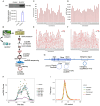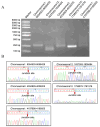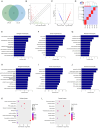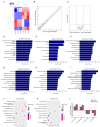Genome-Wide Characterization of Extrachromosomal Circular DNA in the Midgut of BmCPV-Infected Silkworms and Its Potential Role in Antiviral Responses
- PMID: 39859532
- PMCID: PMC11766159
- DOI: 10.3390/ijms26020818
Genome-Wide Characterization of Extrachromosomal Circular DNA in the Midgut of BmCPV-Infected Silkworms and Its Potential Role in Antiviral Responses
Abstract
Extrachromosomal circular DNAs (eccDNAs) has been found to be widespread and functional in various organisms. However, comparative analyses of pre- and post-infection of virus are rarely known. Herein, we investigated the changes in expression patterns of eccDNA following infection with Bombyx mori cytoplasmic polyhedrosis virus (BmCPV) and explore the role of eccDNA in viral infection. Circle-seq was used to analyze eccDNAs in the midgut of BmCPV-infected and BmCPV-uninfected silkworms. A total of 5508 eccDNAs were identified, with sizes varying from 72 bp to 17 kb. Most of eccDNAs are between 100 to 1000 bp in size. EccDNA abundance in BmCPV-infected silkworms was significantly higher than in BmCPV-uninfected silkworms. GO and KEGG analysis of genes carried by eccDNAs reveals that most are involved in microtubule motor activity, phosphatidic acid binding, cAMP signaling pathway, and pancreatic secretion signaling pathways. Several eccDNAs contain sequences of the transcription factor SOX6, sem-2, sp8b, or Foxa2. Association analysis of eccDNA-mRNA/miRNA/circRNA revealed that some highly expressed genes are transcribed from relevant sequences of eccDNA and the transcription of protein coding genes influenced the frequency of eccDNA. BmCPV infection resulted in changes in the expression levels of six miRNAs, but no known miRNAs with altered expression levels due to changes in eccDNA abundance were identified. Moreover, it was found that 1287 and 924 sequences representing back-spliced junctions of circRNAs were shared by the junctions of eccDNAs in the BmCPV-infected and uninfected silkworms, respectively, and some eccDNAs loci were shared by circRNAs on Chromosomes 2, 7, 11, 14, and 24, suggesting some eccDNAs may exert its function by being transcribed into circRNAs. These findings suggest that BmCPV infection alter the expression pattern of eccDNAs, leading to changes in RNA transcription levels, which may play roles in regulating BmCPV replication. In the future, further experiments are needed to verify the association between eccDNA-mRNA/miRNA/circRNA and its function in BmCPV infection.
Keywords: BmCPV; circRNA; eccDNAs; mRNA; miRNA.
Conflict of interest statement
The authors declare no conflict of interest.
Figures







Similar articles
-
Identification and characterization of circular RNAs in the silkworm midgut following Bombyx mori cytoplasmic polyhedrosis virus infection.RNA Biol. 2018 Feb 1;15(2):292-301. doi: 10.1080/15476286.2017.1411461. Epub 2017 Dec 21. RNA Biol. 2018. PMID: 29268657 Free PMC article.
-
Identification and characterization of extrachromosomal circular DNA in the silk gland of Bombyx mori.Insect Sci. 2023 Dec;30(6):1565-1578. doi: 10.1111/1744-7917.13191. Epub 2023 Apr 10. Insect Sci. 2023. PMID: 36826848
-
Functional characterization of a novel protein-coding circular RNA, circRNA_1193, from the mAAP gene in silkworm and its role in antiviral defense against BmCPV.mBio. 2025 May 14;16(5):e0012525. doi: 10.1128/mbio.00125-25. Epub 2025 Mar 28. mBio. 2025. PMID: 40152619 Free PMC article.
-
Extrachromosomal circular DNA: A neglected nucleic acid molecule in plants.Curr Opin Plant Biol. 2022 Oct;69:102263. doi: 10.1016/j.pbi.2022.102263. Epub 2022 Jul 21. Curr Opin Plant Biol. 2022. PMID: 35872391 Review.
-
Extrachromosomal Circular DNAs: Origin, formation and emerging function in Cancer.Int J Biol Sci. 2021 Mar 2;17(4):1010-1025. doi: 10.7150/ijbs.54614. eCollection 2021. Int J Biol Sci. 2021. PMID: 33867825 Free PMC article. Review.
References
-
- Moller H.D., Ramos-Madrigal J., Prada-Luengo I., Gilbert M.T.P., Regenberg B. Near-Random Distribution of Chromosome-Derived Circular DNA in the Condensed Genome of Pigeons and the Larger, More Repeat-Rich Human Genome. Genome Biol. Evol. 2020;12:3762–3777. doi: 10.1093/gbe/evz281. - DOI - PMC - PubMed
MeSH terms
Substances
Grants and funding
- 22KJB23003/Natural Science Foundation of the Jiangsu Higher Education Institutions of China
- 32072792, 32372946, 32202744/National Natural Science Foundation of China
- 2019YFA0905200/National Key Research and Development Program of China
- CX (23)1042/Jiangsu Agricultural Science and Technology Innovation Fund (JASTIF) of China
- YL13430023/Priority Academic Program of Development of Jiangsu Higher Education Institutions
LinkOut - more resources
Full Text Sources

